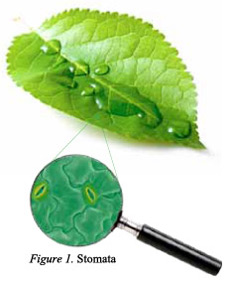Agmin Product Benefits
The following information is introductory material to Agmin liquid fertilizer and chemical products such as fungicides, algicides, and animal nutritional products. This is by no means the complete range of products, and new products are always being formulated, researched and developed at Agmin laboratories. For more information, please Contact Us.
What are the benefits of foliar fertilization nutrients? |
Scientific research conducted in the 1950’s by Dr Tukey and associates at the Michigan State University lead to the validation of the theory that nutrients can be absorbed by foliar application to the leaf. It was shown that the foliar applied nutrients mainly enter through the stomata of the leaf (Figure 1.), and in some cases through the cuticles.
Although the quantity of nutrients absorbed by the leaf during foliar application may be small, it is compensated by a higher efficiency of uptake than applying the same quantity of nutrients to the soil. This is due to specific soil conditions where the nutrients can be lost by leaching, negated by chemical reactions, incorporated into microbial bodies and effected by many other fac- tors in the soil. These factors inhibit a portion, and in severely adverse soil conditions cause a majority of the nutrients to become unavailable to the plant roots. There is a clear advantage of foliar application of nutrients in the case of adverse soil conditions, for the reason that one can overcome limitations of the soil and its ability to transfer nutrients into the plant. However, foliar application of nutrients is by no means a substitution for proper soil fertilizer management. It does however overcome those impediments which are adversely effecting the soil nutrition of plants. A range of other benefits are associated with foliar fertilization. A few points are listed below: |
How do we know what our soil and plants require? |
Soil and plant tissue testing is essential to reach an optimum and healthy crop production. Liebig’s Law of the Minimum states that the growth of the crop is controlled by the scarcest resource. This means that the fertilization element that is scarcest in the soil or plant will be the limiting factor for the development of an optimum crop.
It is therefore recommended by Agmin that at least one soil test is performed prior to planting/seeding, and up to three plant tissue tests during the season to review what the crop requirements are during the growth stages for optimum crop production. Agmin works in conjunction with laboratories that are accredited by the Australian Soil and Plant Analysis Council (ASPAC) in order to ensure that quality of analysis results are fully validated. After the analysis of the soil or plant tissue the results are used in a nutritional evaluation by Agmin’s agronomist to make a recommendation of what actions are available to you for the improvement of your crop. This is important both prior to planting/seeding and during the growth stages of the crop. A single soil or plant tissue test with recommendations is a very inexpensive way to establish any deficiencies or problems in both the soil and the plant. Agmin provides complete cost effective soil tests and plant tissue analyses for all important fertilization elements including test such as Electrical Conductivity, pH, Phosphorous Buffer Index and more. The recommendation from Agmin also contains evaluation of fertilization elements interaction and antagonism. There is a complex interplay between elements, and how they affect each other in the soil plant. Some elements can enhance or suppress each other. An example of this can be seen in figure 2 of the complex interaction and antagonism of elements that has to be taken into consideration during an evaluation. |
Why do Agmin products perform so well? |
Agmin was the first lignosulphonate chelator of micro nutrients in Australia. On this page the terminology and unique features of Agmin’s product range will be discussed, and why the products perform so well, and why they are very cost effective and environmentally friendly.
Lignosulphonate is derived from Lignin and is a by-product of the pulp from the paper industry, meaning they are organic in nature and environmentally friendly. Lignosulphonate is processed prior to usage in Agmin products to break down the lignosulphonate (usual misquoted in the industry by referring to it as low molecular weight lignin, albeit the technical discussion is beyond the scope of this article.) The lignosulphonate in Agmin’s liquid fertilizer range (see next page for product range) has a unique property where it uniformly "chelates" many of the nutrients. Chelating derived from the Greek word "chele" means "claw". This claw or chelate holds on to many nutrients. (Please see the figure at the bottom of the page for a visual representation of the chelation of Zinc.) The lignosulphonated chelation in general terms prevents the nutrients to be immobilized in soil application. In foliar application the lignosulphonate binds the protected nutrients to the leaf, assisting in rain fastness, and the surfactants and penetrants increase the efficacy of absorption. Benefits as a foliar application:
|
An overview of Agmin foliar fertilization products |
The Agmin product range covers all nutrient deficiencies and maintenance applications. Not only is Agmin’s product range very price competitive, but the efficacy compared to traditional liquid fertilizer is greatly enhanced by Agmin’s chelation technologies, and included binders, penetrants and surfactants.
Agmin also offers Prescription Mixes, based n soil or/and plant tissue analysis when ordering 200L or more. This enables Agmin to produce a tailored mix to your crops needs for a single application which also reduces cost. Products range from:
Summary of Agmin product Benefits:
|
Beyond fertilization products: Algicides, Fungicides, & Animal Nutrition |
Agmin offers a range of ag-chemicals. These range from the very popular algicide "Cupricide", a copper complex based algicide that is extremely environmentally friendly, safe, and APVMA registered.
Agmin supplies an APVMA registered Systemic Fungicide named HortiPhos 600 based on 600 g/L Phosphorous Acid to fight phytophthora disease (dieback) and downy mildew, a well known product in the market and cost effective. Agmin supplies a variety of livestock nutritional products, such as the well known Nutrimin range of Drenches (and Drench Plus with vitamins A,D,E). These are supplied in liquid form for application in troughs or directly as a drench to the livestock. In addition to this a product, Nutrimin Pasture Spray, enhances the nutrient quality of the pasture on which the animals graze. Agmin also manufactures Silicon based products that provide a multitude of beneficial effects on crop growth and on resistance to biotic (biological) and abiotic (environmental) stresses, called Organic Silicate Complex and Silfos Complex (with powerful fungicide/herbicide addition). Nutrimin Product Range:
Fungicide:
Algicides:
Silicon Products:
|
For further information on all of our products, please
Contact Us or call our toll free number 1800 154 433.
Contact Us or call our toll free number 1800 154 433.




